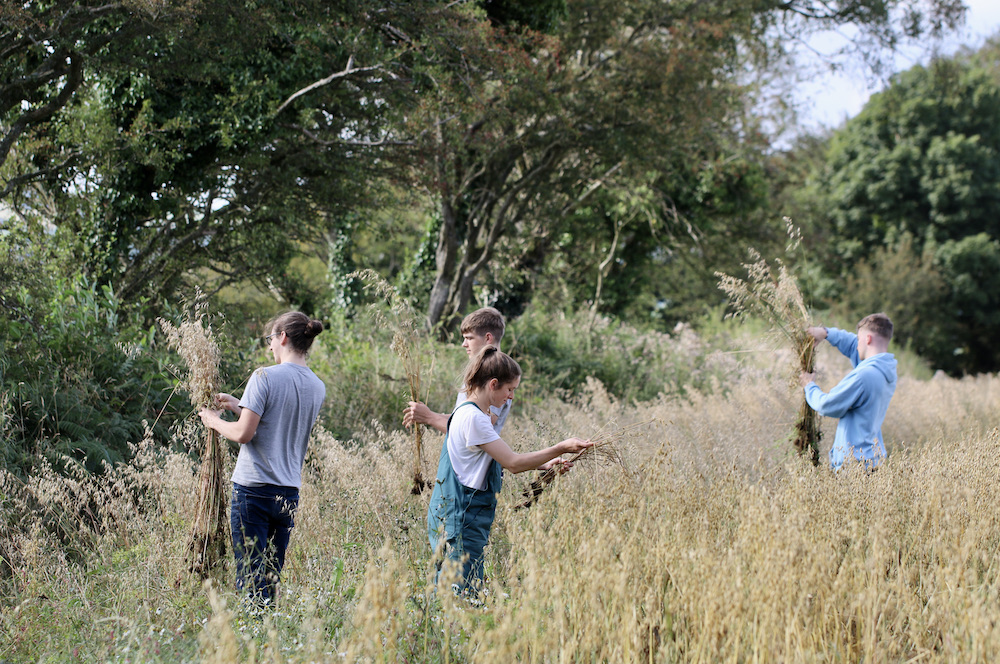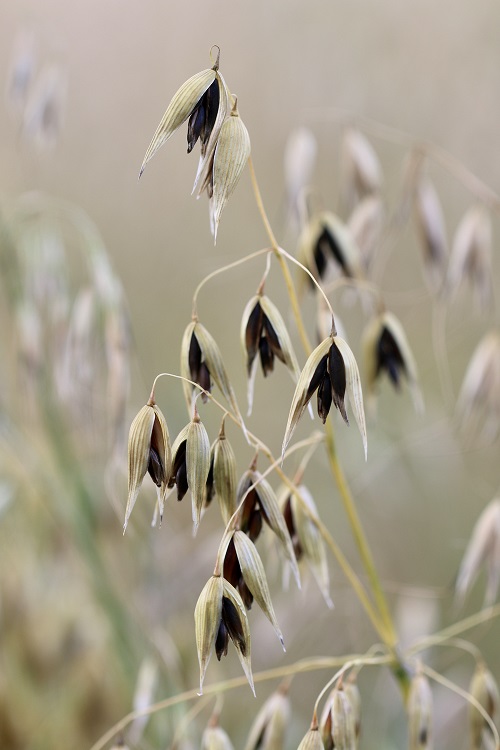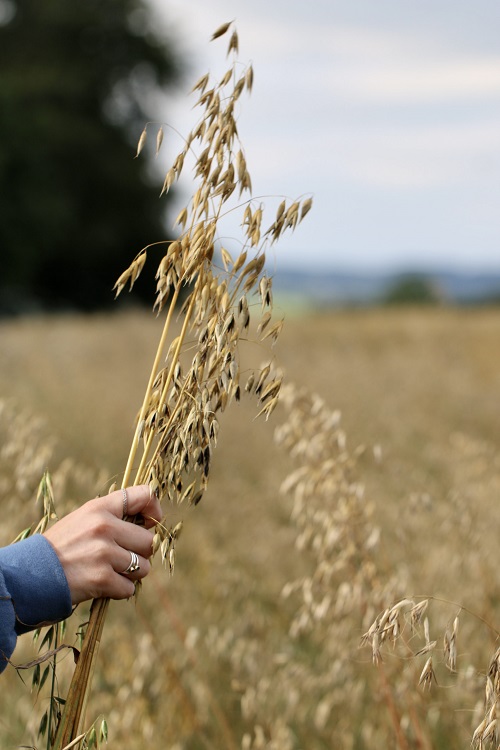Food Tales from Wales

This is part of a monthly series on nation.cymru on the diversity of Welsh food culture by Carwyn Graves, whose book Welsh Food Stories is out now. You can read the first three installments of the series here.
Carwyn Graves
Reviving our Welsh oat culture
The humble oat (ceirch in Welsh) has never received much acclaim in the Anglophone world, but in Wales until within living memory it not only formed a cornerstone of our food but was highly fêted in our culture.
Now, a budding collection of farmers, plant scientists, conservationists and folk musicians are working hard to bring back a component of our heritage that may hold one of the keys to feeding our future.
The story of ‘Llafur Ni’ – this group of farmers and growers working to re-introduce native grains into cultivation again in Wales – starts with ceirch du bach. This beautiful, ancient crop with its nutty, creamy and flowery flavour was a mainstay on mixed farms across western Wales until the 1960s, but was pushed out in most places by the changes in farming during that period.
On some farms, however, the practice clung on into the 2010s, providing a crucial genetic link to the past. Other Welsh varieties of oat died out in cultivation, but were stored for posterity by the IBERS institute at Aberystwyth University. Now, Llafur Ni are working together to bulk up seed stock from 14 of these rare oat varieties.
The importance of this for all our futures may yet turn out to be profound. Oats are one of the few grain crops whose production globally has declined over recent decades, but it is in fact one of the grains most able to produce a harvest in adverse conditions and with lower fertilizer requirements.
On top of this, unlike even the best variety of rye or wheat, oats are naturally gluten-free and high both in antioxidants and beta-glucan. And significantly, native varieties of oats may well also be higher in protein content than conventional modern cultivars.

Culture
These then are crops to be celebrated; and it turns out that Welsh culture has a long history of doing exactly that, with oats cropping up in almost every part of our rural heritage.
Into the mid-20th century, there were multiple implements in households across the country specifically for storing and preparing oats: the cist styffylog, in which kilos of oatmeal were kept through the winter, the wtffon used for divining whether oat drinks were ready or the car bara ceirch; not a car but a rack for drying oatcakes made on the griddle.
But well outside the kitchen, oats had made their mark on the landscape and on social life. The number of occurrences of ‘Cae Ceirch’ as a placename across the country runs to well over a hundred, while places called ‘Bryn Ceirch’ crop up everywhere from the Carmarthenshire countryside to Llangollen and Dolgellau.
And one of the highlights of young people’s social calendar in many rural areas till shortly before the second world war since time immemorial was the so-called ‘Shimli’; an informal evening of riotous entertainment tied to the drying and grinding of oats and barley.
This being Wales, we find echoes of this throughout our rich corpus of poetry and folk song – some of which is now being sung anew by artists such as Cynefin and Gwilym Bowen Rhys. These celebrate in ancient, living Welsh meter the humane process of co-working to produce the year’s food, such as this englyn (short strict-metre poem) by the Ceredigion folk poet, Alun Cilie:
Helem
Trysor aeddfed pen medi – Awst a’i aur
Wedi’i storio ynddi;
O faeth hael ei chyfoeth hi
Yd a gawn i’n digoni
(The Rick
The ripe treasure of autumn’s head – August’s gold
All stored for bread;
From its nourishment of its riches
We gather in grain and are fed)
Perhaps even more notable is the way specific varieties are celebrated in verse, as in a recent poem by Dic Jones (died 2011) to poet Tudur Dylan to congratulate his winning a bardic chair, where he compares Dylan to the ‘ceirch du bach/ yn agor eto’i lygad/ o’i stôr i arlwyo’r wlad’ (‘The little black oat / opening again its eye/ from its reserves, to feed again the land).
‘Feeding the land’ celebrated in verse; here we have but one instance among so many within the poetic corpus of this interweaving of sustainable agricultural practice with the voice of the muse.

Cuisine
Feeding is of course the apposite word here, and despite the modern misconception that oats equal little more than porridge, the range of culinary uses to which they were skilfully put in Wales within living memory is ripe for rediscovery.
Not only are oats a mainstay of one of the finest and most nutritious of all breakfast foods – real laverbread, where the laver is rolled in oatmeal and fried in bacon fat – but they also served as the basis for one of North Wales’ most intriguing early streetfoods.
‘Cocos a Wya’ – ‘cockles and eggs’ – consists of both ingredients fried with onions and a pinch of salt and pepper and then served between slices of oatbread, and traditionally sold from door to door in Gwynedd seaside villages.
Oats were also one of the core ways that the people of Wales, well before the advent of yoghurt and kefir, consumed a healthy level of fermented foods in their diet.
Numerous dishes, including twists on porridge, involved steeping oats in water for several days in order to allow the oats to ferment before preparation into llymru, sucan gwyn or bwdram.
Many of these were served up at harvest time until the 1970s in more mountainous parts of the country and were held – probably correctly – to have health-giving qualities.
Climate
Our general cultural amnesia regarding oats then is hard to understand, other than that in our national subconscious we still see them as an old, native workhorse, and so almost inherently unsexy.
This was always at best a conceit of modern culture, convinced in the face of nature’s diversity that a little more chemistry would do the trick – to disastrous effects as we now know.
And given the difficulty that even the UK as one of the richest countries in human history now has in securing a sufficient and healthy diet for its citizens, the oat – and native varieties in particular – are likely to have a critical role to play over coming decades.
In the teeth of a rapidly deteriorating climate, the need for food security is urgent, and the work of building resilience and diversity back into our grain-growing system as is now happening here with the native oats comes in the nick of time.
For although there is clearly a place for experimentation with novel foods (insects, cultured meat) in the face of global challenges, half of global calories come from grains.
They are quite simply what keep us alive, and that isn’t likely to change soon. In our part of the world, the Welsh oats and their culture clearly have an important role to play.
Support our Nation today
For the price of a cup of coffee a month you can help us create an independent, not-for-profit, national news service for the people of Wales, by the people of Wales.







Great and timely piece.We continue to have a minimal arable sector in Cymru despite having far more suitable land than popularly believed. Older varieties aside, there remains a glaring gap for supplying Porridge and Oat products grown and processed in Cymru to our own public.
“More suitable land than popularly believed”
Back in the day most farms grew a range of crops for local consumption…
Oat milk does not create methane or slurry and is growing in popularity and is perfect for use with oats for breakfast. Gluten sensitive folks check the label…
Agreed. I prefer oat milk to Dairy. At the moment the only disqualifier is price. We are still paying “artisan” prices for what is essentially oats soaked in water strained through a sock. Pretty sure it’s gluten free and of course doesn’t trouble the lactose intolerant
If paying a few shekels more helps to keep my local vegan shop in Porthmadog going then it is an investment for the public good…
Desperate to try these now. If they are not already, as soon as they become commercially available for consumption, please let us know? My love of oats is second only to my love of beans.
It always irks me when I return to Wales that there is no native bara ceirch available for sale and I love the refrain of Yr Hen Wr Mwyn, “yn gwrando ar yr uwd yn berwi”, “listening to the porridge bubbling”, as he sat by the fire at night. When it comes to beans, stwnch ffa is my favourite, and I often make it.
Ai’r un grawn yw ‘ceirch du’ â ‘blé noir’ sydd yn brif gynhwysyn un math ar grempog Llydewig? A beth yw ‘buckwheat’ yn Gymraeg ac a ddefnyddid e yma?
Is Ceirch Du the same as the Blé Noir that is used for pancakes in Brittany? And is it the same as buckwheat?